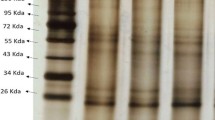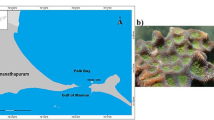Abstract
Multixenobiotic resistance (MXR) represents an important cellular detoxification mechanism in aquatic organisms as it provides them robustness toward natural and man-made contaminants. Several ABC transporters have major roles in the MXR phenotype – P-gp/ABCB1, MRP1–3/ABCC1–3 and BCRP/ABCG2. In this study, we identified the presence of ABC transporters involved in the MXR mechanism of Arbacia lixula and Paracentrotus lividus. AlABCB1/P-gp, AlABCC3/MRP3, AlABCC9/SUR-like and AlABCG-like transcripts were identified in A. lixula; and PlABCC1/P-gp, PlABCC3/MRP3, PlABCC5/MRP5, and PlABCC9/SUR-like transcripts in P. lividus. For each of the new partial sequences, we performed detailed phylogenetic and identity analysis as a first step toward full characterization and understanding of the ecotoxicological role of these ABC transporters.

Similar content being viewed by others
References
Arslan O, Parlak H (2007) Embryotoxic effects of nonylphenol and octylphenol in sea urchin Arbacia lixula. Ecotoxicology 16:439–444
Bard SM (2000) Multixenobiotic resistance as a cellular defense mechanism in aquatic organisms. Aquat Toxicol 48:357–389
Bošnjak I, Uhlinger KR, Heim W, Smital T, Franekić Čolić J, Coale K, Epel D, Hamdoun A (2009) Multidrug efflux transporters limit accumulation of inorganic, but not organic, mercury in sea urchin embryos. Environ Sci Technol 43:8374–8380
Bošnjak I, Šegvić T, Smital T, Franekić J, Mladineo I (2011) Sea urchin embryotoxicity test for environmental contaminants – potential role of the MRP proteins. Water Air Soil Pollut 217:627–636
Cesar A, Marín A, Marín-Guirao L, Vita R (2004) Amphipod and sea urchin tests to assess the toxicity of Mediterranean sediments: the case of Portmán Bay. Sci Mar 68:205–213
Cole SP, Deeley RG (2006) Transport of glutathione and glutathione conjugates by MRP1. Trends Pharmacol Sci 27:438–446
Epel D, Luckenbach T, Stevenson CN, MacManus-Spencer LA, Hamdoun A, Smital T (2008) Efflux transporters: newly appreciated roles in protection against pollutants. Environ Sci Technol 42:3914–3920
Goldstone JV, Hamdoun A, Cole BJ, Howard-Ashby M, Nebert DW, Scally M, Dean M, Epel D, Hahn ME, Stegeman JJ (2006) The chemical defensome: environmental sensing and response genes in the Strongylocentrotus purpuratus genome. Dev Biol 300:366–384
Hamdoun A, Epel D (2007) Embryo stability and vulnerability in an always changing world. Proc Natl Acad Sci USA 104:1745–1750
Hamdoun AM, Cherr GN, Roepke TA, Epel D (2004) Activation of multidrug efflux transporter activity at fertilization in sea urchin embryos (Strongylocentrotus purpuratus). Dev Biol 276:452–462
Kurelec B (1992) The multixenobiotic resistance mechanism in aquatic organisms. Crit Rev Toxicol 22:23–43
Panten U, Schwanstecher M, Schwanstecher C (1996) Sulfonylurea receptors and mechanism of sulfonylurea action. Exp Clin Endocrinol Diabetes 104:1–9
Sea Urchin Genome Sequencing Consortium (2006) The genome of the sea urchin Strongylocentrotus purpuratus. Science 314:941–952
Shipp LE, Hamdoun A (2012) ATP-binding cassette (ABC) transporter expression and localization in sea urchin development. Dev Dyn 241:1111–1124
Smital T, Luckenbach T, Sauerborn R, Hamdoun AM, Vega RL, Epel D (2004) Emerging contaminants – pesticides, PPCPs, microbial degradation products and natural substances as inhibitors of multixenobiotic defense in aquatic organisms. Mutat Res 552:101–117
Szakács G, Váradi A, Özvegy-Laczka C, Sarkadi B (2008) The role of ABC transporters in drug absorption, distribution, metabolism, excretion and toxicity (ADME–Tox). Drug Discov Today 13:379–393
Acknowledgments
This work has been supported by the Ministry of Science, Education and Sports of the Republic of Croatia, Project Nos. 058-0582261-2246 and 098-0982934-2745.
Author information
Authors and Affiliations
Corresponding author
Electronic supplementary material
Below is the link to the electronic supplementary material.
Rights and permissions
About this article
Cite this article
Bošnjak, I., Zaja, R., Klobučar, R.S. et al. Identification of ABC Transporter Genes in Gonad Tissue of Two Mediterranean Sea Urchin Species: Black, Arbacia lixula L., and Rocky, Paracentrotus lividus L.. Bull Environ Contam Toxicol 91, 415–419 (2013). https://doi.org/10.1007/s00128-013-1021-8
Received:
Accepted:
Published:
Issue Date:
DOI: https://doi.org/10.1007/s00128-013-1021-8




